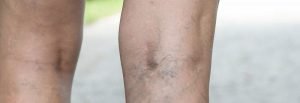Varicose veins are enlarged, bulging, and bluish-green veins often visible on the thighs and legs. In some cases, these veins are twisted and highly noticeable, even when sitting or standing. While varicose veins are not typically linked to serious health issues, they can cause certain symptoms, such as:
- Cramps or leg pain. Discomfort in the thighs, especially after long periods of standing.
- Swelling in the feet and legs. Often due to poor circulation.
- Frequent muscle spasms. Sudden and involuntary contractions in the feet or legs.
- Changes in skin color. Darkened patches on the legs and feet.
- Easy bruising. Increased likelihood of bruising in the thigh area.
What Causes Varicose Veins?

Varicose veins form when one or more valves in the veins fail to function properly. These valves are responsible for preventing the backward flow of blood. When they malfunction, blood pools in one section of the vein, causing it to enlarge, bulge, and turn bluish in color.
Who Is at Risk of Developing Varicose Veins?
Certain conditions increase the likelihood of developing varicose veins:
- Pregnancy. Pregnant women are at a higher risk due to increased blood volume and changes in blood circulation, particularly in the legs.
- Aging. As individuals age, veins lose elasticity, making them more prone to blood pooling.
- Excess weight. Overweight or obese individuals are more likely to develop varicose veins due to added pressure on veins, which can weaken vein valves.
How Are Varicose Veins Treated or Removed?
Although varicose veins typically do not have serious health implications, some individuals may seek treatment for cosmetic reasons or to alleviate symptoms. Medical procedures to treat varicose veins include:
- Wearing compression stockings. These help improve blood flow and prevent veins from bulging.
- Endothermal ablation. A procedure that uses heat to close damaged veins.
- Sclerotherapy. A special solution is injected into varicose veins to make them fade.
- Ligation and stripping. Surgical removal of the affected veins.
How to Prevent Varicose Veins?
While not all cases of varicose veins are preventable, the following habits can help reduce the risk:
- Avoid prolonged standing. Take breaks to move around after standing for more than 30 minutes.
- Elevate your legs. Rest your legs by propping them up to aid blood circulation.
- Exercise regularly. Physical activity promotes overall cardiovascular health and helps maintain healthy blood flow.
Varicose veins can be managed or prevented with healthy habits and, if necessary, medical treatments. If symptoms persist or cause discomfort, consult a healthcare professional to discuss suitable options.


